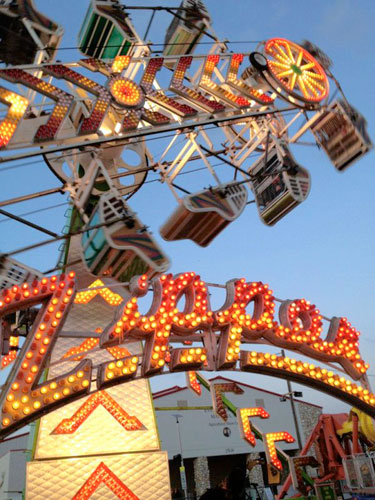Five years ago, documentary filmmaker Amy Nicholson turned her lens on an old-school Coney Island carny and his crazy revolving attraction on the W. 12th Street shoreline. The result was “Zipper: Coney Island’s Last Wild Ride,” a fascinating look at politics, profit, and power in the People’s Playground.
Will Bredderman: So, congratulations on the film finally opening — but why not in Brooklyn?
Amy Nicholson: I wanted it to open at the Brooklyn Film Festival, but we finished on film and it really took a long time to develop and I missed the deadline.
WB: So why did you decide to make a movie about the Zipper?
AN: I rode a Zipper as a kid. I’m originally from Maryland, and I grew up spending my summers in Ocean City, which had a Zipper. There’s a few of them out there. In 2006, I just read in the Daily News one day that the Zipper was leaving Coney Island, and I thought “That’s so sad, I love the Zipper.” So I decided I wanted to go there and talk to the people who ran it, and it ended up becoming a much more complicated story than I expected.
WB: Who was running it? And what made it all so darn complicated?
AN: Eddie Miranda, he was the man running it, and he said he was fighting for one more summer when I went to speak to him in Feb. 2007. He basically told me he couldn’t talk about it, and I assumed there was a gag order going on, since I’d read Joe Sitt had bought the property he was on. Later on after he had to leave, he opened up to us. We went to the local city councilman, Domenic Recchia. After his interview, I had 10,000 more questions so I decided to keep going. I interviewed over the next four years Seth Pinsky, Lynn Kelly, and Joe Sitt.
WB: So you think there was collusion between Sitt and the city?
AN: No. I always felt, just my gut feeling, is that Sitt beat them to the punch. The city should’ve known the second they announced they had a plan to encourage private developers to build amusements in Coney Island, somebody like Joe Sitt was going to swoop in and buy up all the property and try to sell it at a profit. The real crux of the story is the parkland swap, and the rezoning. After Joe Sitt came in, with all his pretty drawings, everybody freaked out — “condominiums in the amusement district!” And their answer was to put the amusements on public parkland. Which sounded great, except the amusements were on private property, and they couldn’t just make that parkland. So they had to swap it for property they owned on the other side of MCU Park, where the parking lot is. So they got to say “We saved the amusement district,” but what they left out is that the amusement district was already protected because it was zoned so that nothing could be built there but amusements. So their plan wasn’t much different than Joe Sitt’s.
WB: So whatever happened to Miranda and the Zipper?
AN: The Zipper got sold to a resort in Honduras. Eddie’s now living in Florida and doing a different job — he hasn’t given me the okay to say where or what.
WB: Okay then. So let me ask: the boardwalk — wood or concrete?
AN: Of course I hate the concrete. Everybody hates the concrete. There’s too much concrete in the world.
“Zipper: Coney Island’s Last Wild Ride” at the IFC Center [323 Sixth Ave. between Cornelia and Carmine streets in Manhattan. (212) 924–7771] Feb. 5, 8 pm.
Reach reporter Will Bredderman at (718) 260–4507 or e-mail him at wbredderman@cnglocal.com. Follow him on Twitter at twitter.com/WillBredderman

























